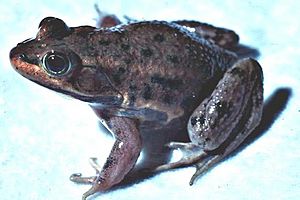Carpenter frog facts for kids
Quick facts for kids Carpenter frog |
|
|---|---|
 |
|
| Conservation status | |
| Scientific classification | |
| Synonyms | |
|
Rana virgatipes Cope, 1891 |
The carpenter frog (Lithobates virgatipes) is a type of true frog. You can find it along the Atlantic coast of the United States. It lives from central New Jersey down to northeastern Florida.
Contents
What Does the Carpenter Frog Look Like?
Carpenter frogs are easy to spot because they are all brown. They have two bright yellow stripes on each side of their back. Their tail is gray, and their belly is usually white or yellow.
Unlike some other frogs, the webbing on their toes does not reach their longest toe. A cool fact about them is their call! It sounds just like a carpenter hammering. This is how they got their name.
These frogs are medium-sized, growing to about 4.1 to 6.6 centimeters long. That's about the size of your palm! When a male frog calls, its throat pouch inflates into a round shape.
Where Do Carpenter Frogs Live?
Carpenter frogs live in the Atlantic coastal plains of the United States. You can find them from the pine forests of New Jersey all the way to Georgia. They are also found in Florida, but they are not as common there.
These frogs usually stay in water and rarely go on land. They are special because they can live in acidic waters. You might find them in cypress ponds, swamps, or canals. They often live near sphagnum moss and other plants in dark, tea-colored water. This helps them blend in. Because they like sphagnum moss so much, people sometimes call them "sphagnum frogs." They need these plants in shallow water for safety and to lay their eggs.
How Do Carpenter Frogs Reproduce?
Carpenter frogs breed for a long time, usually for two to three months. This breeding season starts when the weather gets warm, usually in late April. It continues until late July or early August.
Male frogs claim small areas, about 1 meter wide. They make mating calls almost every night during the breeding season. Smaller males have higher-pitched calls than larger males. They call from sunset until sunrise, but they call the most around midnight.
After mating, female frogs lay egg masses. Each mass has about 200 to 600 eggs. They attach these round egg masses to plants underwater, usually about 8 inches deep.
The Carpenter Frog Life Cycle
Tadpoles hatch from the eggs about one week after they are laid. These tadpoles stay in their watery stage for about one year. Then, between August and September, the tadpoles change into young frogs. This process is called metamorphosis.
What Do Carpenter Frogs Eat?
Carpenter frogs mostly eat insects and other small creatures that live in the water. This includes things like crayfish and spiders.
What Threats Do Carpenter Frogs Face?
One big problem for carpenter frogs is losing their homes. Their habitats are being damaged or disappearing. For example, in the 1990s, the number of carpenter frogs in Talbot County dropped a lot. This was likely due to their habitat being harmed.
In some areas, like South Georgia, carpenter frogs are common. However, they only live in a small range. Since they need wetlands with lots of plants for breeding, human activities like digging ditches and building cities hurt their homes.
Carpenter frogs are known to live well in acidic water. But over time, some wetlands, especially in the Delmarva region, have become less acidic. This is a problem for the carpenter frog because they cannot adapt to these changes. When the water is less acidic, other types of frogs can move in. These new frogs might be more aggressive. For example, northern green frogs can be a threat.
Other frogs like American Bullfrogs (Lithobates catesbeianus) and Pig Frogs (Lithobates grylio) also cause problems for carpenter frogs. Some research also suggests that water snakes (Nerodia) hunt and eat carpenter frogs.
See also
 In Spanish: Lithobates virgatipes para niños
In Spanish: Lithobates virgatipes para niños


